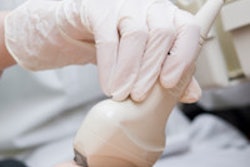For detecting renal calculi with CT, even dose reductions as high as 75% didn't reduce sensitivity for stones 3 mm and larger, according to a new study from Ohio's Cleveland Clinic. And because smaller stones are more likely to pass, significant dose reductions may be possible without missing the larger and more problematic calculi.
Unenhanced CT is the mainstay modality for detecting renal stones (usually in the emergency department), and the number of scans for this indication has increased substantially in recent years, wrote Dr. Michael Ciaschini and colleagues in Radiology.
Most troubling has been the steady rise in repeat examinations, "which is likely driven in part by a rate of stone recurrence estimated to be as high as 35% per 10-year period," they wrote (Radiology, February 27, 2009).
Many patients undergo repeat exams. In 2004, Katz et al found that 4% of patients undergoing unenhanced CT for renal colic over six years had three or more exams. "The repeat radiation exposure is particularly concerning because of the relatively young age of this patient population," Ciaschini and his team wrote.
Considering the need for dose reduction to accommodate repeated exams, the authors aimed to determine the effects of a 50% and 75% dose reduction on CT's sensitivity and specificity for detecting urinary calculi.
They performed an analysis at three dose levels (two simulated) on 47 patients who had undergone unenhanced CT after presenting with flank pain. The mean patient age was 53.4 years for men (n = 24, age range 26.6 to 84.9 years) and 38.6 years for women (n = 23, age range 16.1 to 63 years), an age difference that reached statistical significance (p = 0.003).
Patients were scanned with a 16-detector-row CT scanner (Siemens Healthcare, Malvern, PA) at 120 kVp, using 0.75-mm collimation, with tube current adjusted according to body habitus (104 to 322 mA, mean 177 mA) using an automated dose modulation algorithm (CareDose, Siemens).
Simulated dose reductions of 50% and 25% of the original tube current were applied to data from all 47 patients, creating a total of 141 exams. The mean tube current was 178 mA for the 100% reconstructions, 88 mA for the 50% reconstructions, and 44 mA for the 25% reconstructions.
The largest and smallest calculi 1 mm or larger were identified in all patients, and the process was repeated for each patient's 50% and 25% reformations by two experienced abdominal radiologists who were blinded to the findings at 100% radiation dose.
The combined sensitivities of the readers for all calculi and those larger than 3 mm are shown.
Sensitivity for calculi detection according to decreasing tube current
|
||||||||||||||||
"There was no significant difference between the 100% examinations and the 50% and 25% reconstructions for detection of stones greater than 3 mm (p = 0.106 and 0.099, respectively)," the group wrote.
Considering all stone sizes, a statistically significant decrease was found in overall sensitivity for all calculi at 25% tube current compared with 100% tube current, and each reader showed a marginally statistically significant decrease in overall sensitivity compared to the 50% tube current setting.
But the reduction in sensitivity for the smallest calculi must be considered in the context of clinical importance.
"Prior studies have shown that the spontaneous passage rate for calculi 2-4 mm in diameter is 76% to 95% and that intervention is rarely needed for calculi smaller than 3 mm," Ciaschini and his team wrote. "In some clinical settings, the detection of stones with a high likelihood of spontaneous passage (< 3 mm) may not be clinically important. While sensitivity for all calculi decreased by approximately 27% with a 75% reduction in tube current in our study, sensitivity for calculi greater than 3 mm fell only 5.8% with a 75% reduction."
The authors cited several limitations: Principally, that the blinded readers might have detected "visibly perceptible image noise" to identify low-dose simulations. The design was retrospective and the sample size small, they wrote. Finally, the investigators didn't evaluate the accuracy of the CT findings in the context of urinary obstruction. The high rate of disease recurrence inherent to the natural history of nephrolithiasis makes repeat CT imaging inevitable in many patients.
But in the end, even when dose was reduced by as much as 75%, sensitivity for calculi larger than 3 mm dropped by only 5.8%, the authors concluded.
"Therefore, in patients with known calculi greater than 3 mm being evaluated for recurrent pain or residual calculi or when calculi 3 mm or smaller are viewed as not clinically important due to their high probability of spontaneous passage, a protocol with up to a 75% reduction in dose should be considered," they wrote. "Our recommendation is for radiologists to use a low-dose renal stone protocol in any patient with known stone disease, especially when reassessing calculi that are greater than 3 mm."
By Eric Barnes
AuntMinnie.com staff writer
March 18, 2009
Related reading
Imaging shows signs of melamine poisoning in Chinese infants, March 2, 2009
DECT permits more detailed urinary stone analysis, December 4, 2008
Low-dose CT offers first-line exam for suspected urolithiasis, September 15, 2008
CT for suspected kidney stones often uncovers other findings, June 5, 2006
Copyright © 2009 AuntMinnie.com



















